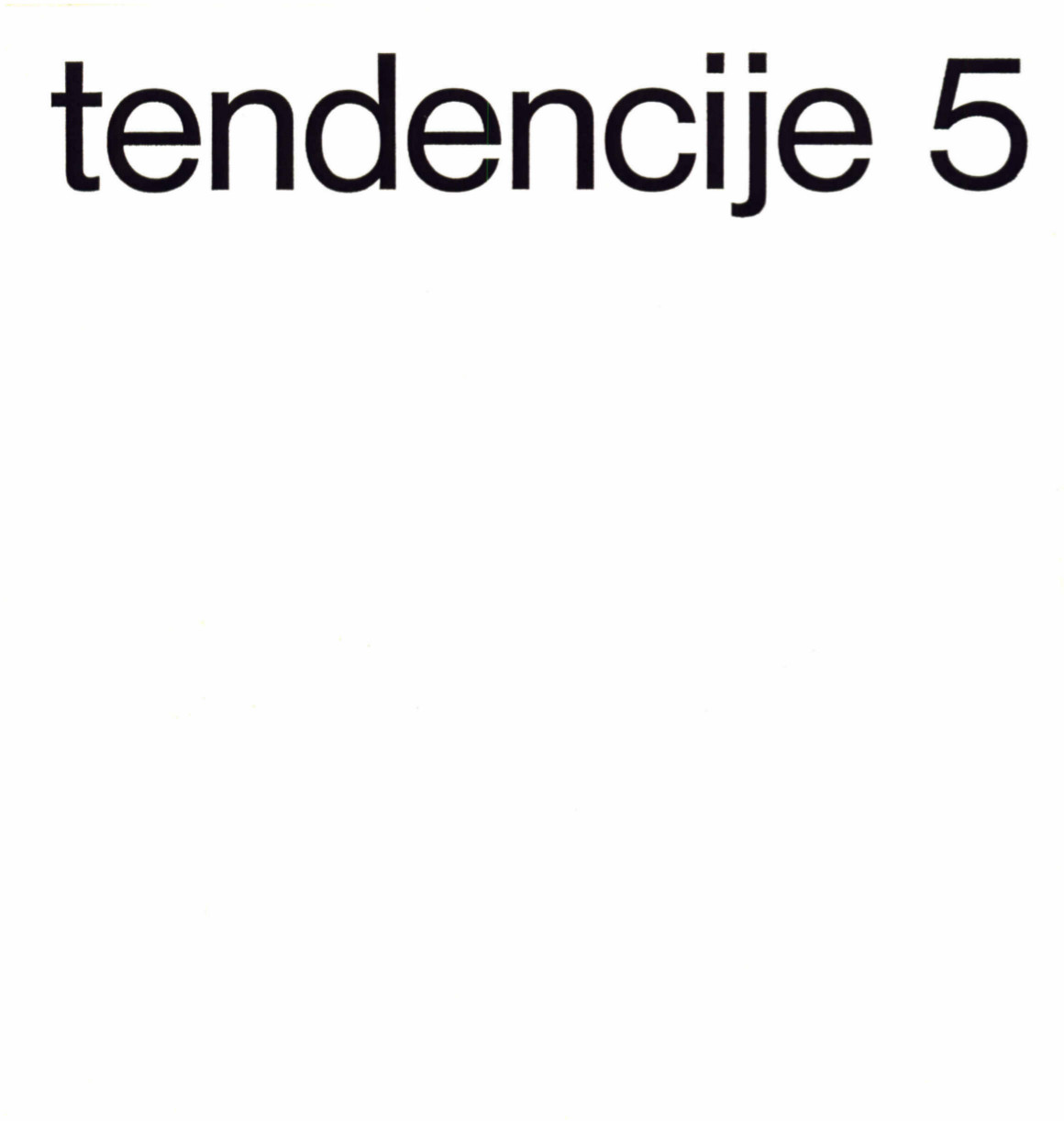Tendencije / Tendencies, 2, 4, 5 (1963-73) [SC, FR, DE, IT, EN]
Filed under book | Tags: · art, computer art, conceptual art, design, kinetic art, op art



Catalogues of the exhibition series New Tendencies held in Gallery of Contemporary Art, Zagreb.
Nove tendencije 2
Texts by Matko Meštrović and Radoslav Putar.
Publisher Galerija suvremene umjetnosti, Zagreb, 1963
[68] pages
Tendencije 4 / Tendencies 4: Zagreb, 1968-1969
Edited by Boris Kelemen and Radoslav Putar
Texts and statements by Radoslav Putar, Almir Mavignier, Matko Meštrović, Enzo Mari, Alessandro Carlini, Bernhard Schneider, Alberto Biasi, Gianni Colombo, Milan Dobeš, Herbert W. Franke, Karl Gerstner, Rolf Glasmeier, Rolf Gravenhorst, Hein Gravenhorst, Dieter Hacker, John Gabriel Harries, Gottfried Jäger, Richard Kriesche, Max H. Mahlmann, Marcello Morandini, Zoran Radović, Bernhard Sandfort, Paolo Scheggi, Klaus Staudt, Josef Hermann Stiegler, Jorrit Tornquist, Gabriele de Vecchi, Herman de Vries.
Publisher Galerija suvremene umjetnosti, Zagreb, 1970
[146] pages
Tendencije 5 / Tendencies 5
Edited by Božo Bek, Boris Kelemen and Marijan Susovski
Texts by Radoslav Putar, Božo Bek, Boris Kelemen, Marijan Susovski, Nena Dimitrijević.
Publisher Galerija suvremene umjetnosti, Zagreb, 1973
[137] pages
Nove tendencije 2 (SC, 1963, 63 MB)
Tendencije 4 / Tendencies 4: Zagreb, 1968-1969 (SC/FR,DE,IT,EN, partial scan, 1970, 17 MB)
Tendencije 5 / Tendencies 5 (SC/EN, 1973, 55 MB)
Timothy Druckrey (ed.): Ars Electronica: Facing the Future: A Survey of Two Decades (1999)
Filed under book | Tags: · art, computer art, computing, electronic art, internet, media, media art, technology, theory, video art, virtual reality, web

“For the past two decades the Austrian-based Ars Electronica, Festival for Art, Technology, and Society has played a pivotal role in the development of electronic media. Linking artistic practice and critical theory, the annual festival and symposium bring together scientists, philosophers, sociologists, and artists in an ongoing discourse on the effects of digital media on creativity—and on culture itself.
Drawing on the resources of Ars Electronica’s publications and archives, this anthology collects the essential works that form the core of a contemporary art long dismissed as too technical or inaccessible. The book includes a critical introduction, full bibliography, and texts and artworks from the key figures in the field.
Among the many contributors are Robert Adrian, Roy Ascott, Jean Baudrillard, Heidi Grundmann, Donna Haraway, Kathy Huffman, Friedrich Kittler, Knowbotic Research, Myron Kruger, Laurent Migonneau, Sadie Plant, Florian Rötzer, Paul Sermon, Carl Sims, Christa Sommerer, Woody Vasulka, Paul Virilio, Peter Weibel, and Gene Youngblood.”
Publisher MIT Press, 1999
Electronic Culture: History, Theory, and Practice series, 1
ISBN 0262041766, 9780262041768
449 pages
via Ars Electronica
Reviews: Beryl Graham (Convergence, 2000), Rhizome (2000), Stephen Wilson (Leonardo, 2001), Yvonne Spielmann (Leonardo, 2001), Matthew Griffin (PAJ, 2002).
Comment (0)Armin Medosch: New Tendencies: Art at the Threshold of the Information Revolution, 1961–1978 (2016)
Filed under book | Tags: · art history, computer art, conceptual art, cybernetics, neo-avant-garde, new art practice, new tendencies, non-aligned movement

“New Tendencies, a non-aligned modernist art movement, emerged in the early 1960s in the former Yugoslavia, a non-aligned country. It represented a new sensibility, rejecting both Abstract Expressionism and socialist realism in an attempt to formulate an art adequate to the age of advanced mass production. In this book, Armin Medosch examines the development of New Tendencies as a major international art movement in the context of social, political, and technological history. Doing so, he traces concurrent paradigm shifts: the change from Fordism (the political economy of mass production and consumption) to the information society, and the change from postwar modernism to dematerialized postmodern art practices.
Medosch explains that New Tendencies, rather than opposing the forces of technology as most artists and intellectuals of the time did, imagined the rapid advance of technology to be a springboard into a future beyond alienation and oppression. Works by New Tendencies cast the viewer as coproducer, abolishing the idea of artist as creative genius and replacing it with the notion of the visual researcher. In 1968 and 1969, the group actively turned to the computer as a medium of visual research, anticipating new media and digital art.
Medosch discusses modernization in then-Yugoslavia and other nations on the periphery; looks in detail at New Tendencies’ five major exhibitions in Zagreb (the capital of Croatia); and considers such topics as the group’s relation to science, the changing relationship of manual and intellectual labor, New Tendencies in the international art market, their engagement with computer art, and the group’s eventual eclipse by other “new art practices” including conceptualism, land art, and arte povera. Numerous illustrations document New Tendencies’ works and exhibitions.”
Based on 2012 dissertation from Goldsmiths, University of London.
Publisher MIT Press, 2016
Leonardo series
ISBN 9780262034166, 0262034166
x+395 pages
Reviews: Oliver Schürer (Versorgerin, 2016, DE), Paula Barreiro López (Critique d’art, 2016, FR), Kristian Lukić (Furtherfield, 2017), Tomáš Glanc (Tech & Culture, 2017), Adair Rounthwaite (Art Bulletin, 2018), Adair Rounthwaite (Art Bulletin, 2018), Ivana Bago (ARTMargins, 2019).
HTML
PDF (added on 2022-10-11)

